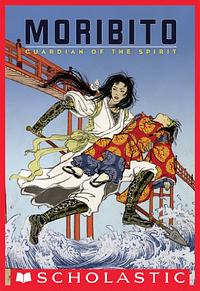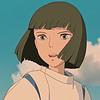Take a photo of a barcode or cover
The last time I read and reviewed this book was back in 2010, when my posts included spoiler-filled synopses that were as long or longer than the reviews themselves. I figured that a new review was in order, especially since my opinion of this book has improved.
After Balsa, a female bodyguard, rescues young Prince Chagum from drowning, she finds herself being roped into being his protector. Chagum is believed to be possessed by the same creature that once caused a terrible drought. It's thought that the drought will be averted if Chagum is killed, so the Mikado himself has ordered several assassination attempts against him. Chagum's mother, the Second Queen, enlists Balsa's help to save him.
While Balsa attempts to hide Chagum and keep him safe from his pursuers, she also seeks out several friends in the hope of figuring out what's going on so that she can somehow both save Chagum's life and prevent the drought.
The first time I read this book was, I think, too soon after having seen the anime. They're both good, but the time I spent noting similarities and differences to the anime made it hard to judge the book on its own merits (yes, I know the book came first, but my first exposure to the story was the anime).
Balsa makes me wish more than the first two books in this series had been translated into English. She's a great character - an experienced and talented warrior with an intriguing past. In general, the book had some nice gender role reversal, with its female stoic warrior character and male healer interested in the spirit world. There was a hint of potential romance between Balsa and Tanda, the healer, but it was handled in a very low-drama way. Tanda was a little frustrated at Balsa's lack of desire to settle down, but it never got to the point of wrecking their friendship.
The "found family" aspect involving Balsa, Tanda, and Chagum was nice. I enjoyed that restful period of the story before everybody had to worry about Chagum's safety again, and it was nice to see Chagum becoming more comfortable and confident in his life as a commoner.
One of the things I really liked about this book was the way the setting and its history mattered. This was very much a story about how knowledge is lost or changed over time. Near the beginning of the book, readers get the history of how New Yogo was founded, but it's entirely from the perspective of the Yogoese, who are currently the area's dominant ethnic group. Later on, readers get more sides of the story - the secret history that only the Star Readers know (which is, again, Yogoese history) and Yakoo stories.
The Yakoo were the people who originally lived in the area where New Yogo was founded. (Supposedly they fled out of fear when the Yogoese peacefully tried to contact them, and I think the Yakoo side of the story agreed with this or at least didn't refute it, but I don't buy it.) They'd lost much of their culture and traditions, and what was left was sometimes mixed with Yogoese culture to an uncertain degree. It gave me shivers to think how close everyone came to not having the knowledge they needed during the chase at the end of the book.
I was surprised at how much I enjoyed rereading this. I haven't read the next book in the series yet, but I'm now looking forward to it even more.
(Original review posted on A Library Girl's Familiar Diversions.)
After Balsa, a female bodyguard, rescues young Prince Chagum from drowning, she finds herself being roped into being his protector. Chagum is believed to be possessed by the same creature that once caused a terrible drought. It's thought that the drought will be averted if Chagum is killed, so the Mikado himself has ordered several assassination attempts against him. Chagum's mother, the Second Queen, enlists Balsa's help to save him.
While Balsa attempts to hide Chagum and keep him safe from his pursuers, she also seeks out several friends in the hope of figuring out what's going on so that she can somehow both save Chagum's life and prevent the drought.
The first time I read this book was, I think, too soon after having seen the anime. They're both good, but the time I spent noting similarities and differences to the anime made it hard to judge the book on its own merits (yes, I know the book came first, but my first exposure to the story was the anime).
Balsa makes me wish more than the first two books in this series had been translated into English. She's a great character - an experienced and talented warrior with an intriguing past. In general, the book had some nice gender role reversal, with its female stoic warrior character and male healer interested in the spirit world. There was a hint of potential romance between Balsa and Tanda, the healer, but it was handled in a very low-drama way. Tanda was a little frustrated at Balsa's lack of desire to settle down, but it never got to the point of wrecking their friendship.
The "found family" aspect involving Balsa, Tanda, and Chagum was nice. I enjoyed that restful period of the story before everybody had to worry about Chagum's safety again, and it was nice to see Chagum becoming more comfortable and confident in his life as a commoner.
One of the things I really liked about this book was the way the setting and its history mattered. This was very much a story about how knowledge is lost or changed over time. Near the beginning of the book, readers get the history of how New Yogo was founded, but it's entirely from the perspective of the Yogoese, who are currently the area's dominant ethnic group. Later on, readers get more sides of the story - the secret history that only the Star Readers know (which is, again, Yogoese history) and Yakoo stories.
The Yakoo were the people who originally lived in the area where New Yogo was founded. (Supposedly they fled out of fear when the Yogoese peacefully tried to contact them, and I think the Yakoo side of the story agreed with this or at least didn't refute it, but I don't buy it.) They'd lost much of their culture and traditions, and what was left was sometimes mixed with Yogoese culture to an uncertain degree. It gave me shivers to think how close everyone came to not having the knowledge they needed during the chase at the end of the book.
I was surprised at how much I enjoyed rereading this. I haven't read the next book in the series yet, but I'm now looking forward to it even more.
(Original review posted on A Library Girl's Familiar Diversions.)
adventurous
fast-paced
I enjoyed this story quite a lot! The action moves at a great pace, and it was wonderful to see the characters meeting one another, bonding together, and learning to understand their connections to the past and to one another. The setting of a mythical magic Japanese-type land was just perfection! I loved the mythical creatures of water and earth, and the mystical magic-weavers, and Star-Readers. Such an imaginative world!
I have never read any Japanese fiction before, but now I will definitely be reading more of this series. Lovely writing!
I have never read any Japanese fiction before, but now I will definitely be reading more of this series. Lovely writing!
I love fantasy and I did like this story. It was fun to read eastern fantasy that isn't based on
the middle ages and in the western society. But the story went along very fast, hence why I've decided
to give this book 3 stars instead of 4. Both Chagum and Balsa goes through a lot of character developement, but to me it feels like only Chagum's arch makes any kind of sense... I would like it to be longer, to have more time to understand Balsa. I am planning on watching the anime version, and then maybe I'll read the following book.
the middle ages and in the western society. But the story went along very fast, hence why I've decided
to give this book 3 stars instead of 4. Both Chagum and Balsa goes through a lot of character developement, but to me it feels like only Chagum's arch makes any kind of sense... I would like it to be longer, to have more time to understand Balsa. I am planning on watching the anime version, and then maybe I'll read the following book.
This book was written in stiff, distant prose, with lifeless characters and a plot that plodded along.
For an excellent samurai story, read "A Samurai's Tale" by Erik Christian Haugaard, or if you are looking for something lighter - The Jude Ooka Samurai Mysteries by Thomas Hoobler, or the Zenta & Matsuzo books by Lensey Namioka.
For an excellent samurai story, read "A Samurai's Tale" by Erik Christian Haugaard, or if you are looking for something lighter - The Jude Ooka Samurai Mysteries by Thomas Hoobler, or the Zenta & Matsuzo books by Lensey Namioka.
Some things I liked about this book:
- Balsa, the female heroine of this novel, is strong and battle-hardened yet still well-written - sadly unlike the vast majority of such characters
- The main characters all could easily fall under the 'chosen one' trope, but didn't read like it. They just feel so overtly 'special', which made the story feel much more real.
- There's a minor romance plotline, but it isn't forced in and just a nice little touch. In fact, it's not even a plotline. The love interest isn't even one of the main focal characters.
- Despite being YA, none of the main characters are teenagers. For some reason, children's novels are often about adults or teens, adult novels about teens and children, but how often do you see books for teens that aren't about teens?
- I loved the writing. It was simple yet captivating, and the action packed scens were expertly done.
- The world-building was artfully done. Uehashi doesn't overwhelm the reader with information, but I found that I fully comprehended this world and its functions.
-The characters could be called 'morally ambigious', but I wouldn't. They're just human.
- Balsa, the female heroine of this novel, is strong and battle-hardened yet still well-written - sadly unlike the vast majority of such characters
- The main characters all could easily fall under the 'chosen one' trope, but didn't read like it. They just feel so overtly 'special', which made the story feel much more real.
- There's a minor romance plotline, but it isn't forced in and just a nice little touch. In fact, it's not even a plotline. The love interest isn't even one of the main focal characters.
- Despite being YA, none of the main characters are teenagers. For some reason, children's novels are often about adults or teens, adult novels about teens and children, but how often do you see books for teens that aren't about teens?
- I loved the writing. It was simple yet captivating, and the action packed scens were expertly done.
- The world-building was artfully done. Uehashi doesn't overwhelm the reader with information, but I found that I fully comprehended this world and its functions.
-The characters could be called 'morally ambigious', but I wouldn't. They're just human.
Moribito: Guardian of the Spirit is an English translation of the first book in a Japanese YA fantasy series following a warrior woman named Balsa. In Guardian of the Spirit, Balsa is hired to protect twelve year old Prince Chagum, who holds the egg of the water spirit. If the egg is destroyed before midsummer, then a great drought will descend across the land.
Balsa is pretty darn awesome. She’s a thirty year old bodyguard who dedicates her life to saving others. But somewhere along the way, fighting got in her bones and now she doesn’t know how to live differently. It’s also nice that she wasn’t the only important female character in the novel.
The world building of Guardian of the Spirit was very well done. There’s two groups of people, one who conquered the other two hundred years back. The people native to the region have begun to forget their myths and legends, which creates trouble for Balsa and Chagum when they are trying to get information about the water spirit.
The book also contains illustrations! It was divided into several sections, and in the division between each section, there was a two page illustrated spread. The artwork was gorgeous. I love it when books incorporate art like this.
Moribito: Guardian of the Spirit is a short and fairly simple adventure story. There are some underlying complexities, especially in Balsa’s characterization and some of the ideas about how those in power shape the stories that are told, but it is a book that could easily be read by a middle school audience. The prose can be a bit simple, and it feels a tad obvious in places (too much telling and not enough showing?). That being said, if you’re older and want a lighter fantasy story, I think you would still enjoy Guardian of the Spirit.
Originally posted on The Illustrated Page.
Balsa is pretty darn awesome. She’s a thirty year old bodyguard who dedicates her life to saving others. But somewhere along the way, fighting got in her bones and now she doesn’t know how to live differently. It’s also nice that she wasn’t the only important female character in the novel.
The world building of Guardian of the Spirit was very well done. There’s two groups of people, one who conquered the other two hundred years back. The people native to the region have begun to forget their myths and legends, which creates trouble for Balsa and Chagum when they are trying to get information about the water spirit.
The book also contains illustrations! It was divided into several sections, and in the division between each section, there was a two page illustrated spread. The artwork was gorgeous. I love it when books incorporate art like this.
Moribito: Guardian of the Spirit is a short and fairly simple adventure story. There are some underlying complexities, especially in Balsa’s characterization and some of the ideas about how those in power shape the stories that are told, but it is a book that could easily be read by a middle school audience. The prose can be a bit simple, and it feels a tad obvious in places (too much telling and not enough showing?). That being said, if you’re older and want a lighter fantasy story, I think you would still enjoy Guardian of the Spirit.
Originally posted on The Illustrated Page.
adventurous
emotional
lighthearted
medium-paced
Plot or Character Driven:
Plot
Strong character development:
Yes
Loveable characters:
Yes
Great world building and all but theres nothing particularly outstanding about it. The main characters are given a hefty amount of introspection time, but its not given as much depth as I would like. The series is obviously in an anthology like format, but this leads to a sense of the plot being rushed and side characters being sidelined hard. Literally for some of the side characters, their job was their personality. But I get it. Single quirk characterizations can be entertaining. Probably it was the gap between the calm campfire story telling narration and the characters that left me dissatisfied. Who knows. 2.5/5.
Solid 3.5. It was weird, the fight scenes were kinda dumb, plot was basically child mpreg (!?) and it turns out that Nahoko Uehashi is like Japanese Tamora Pierce.








